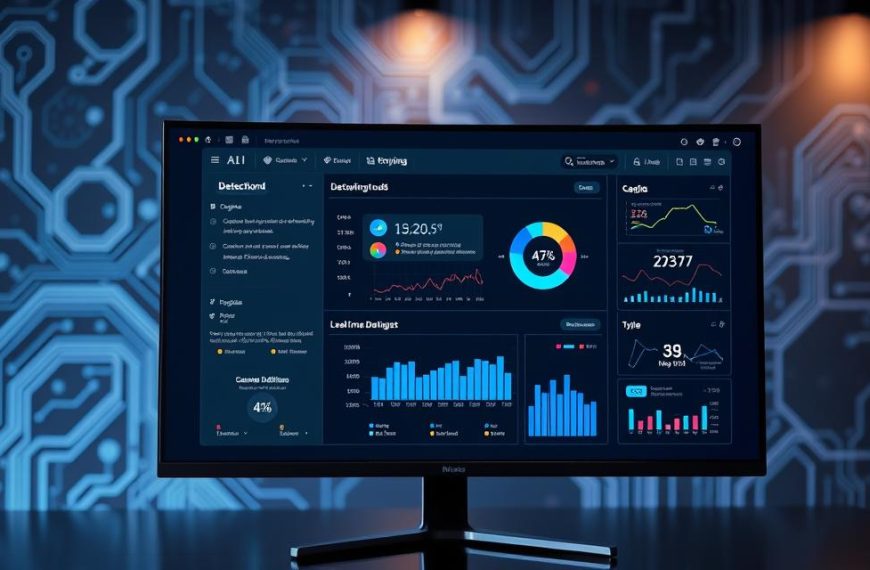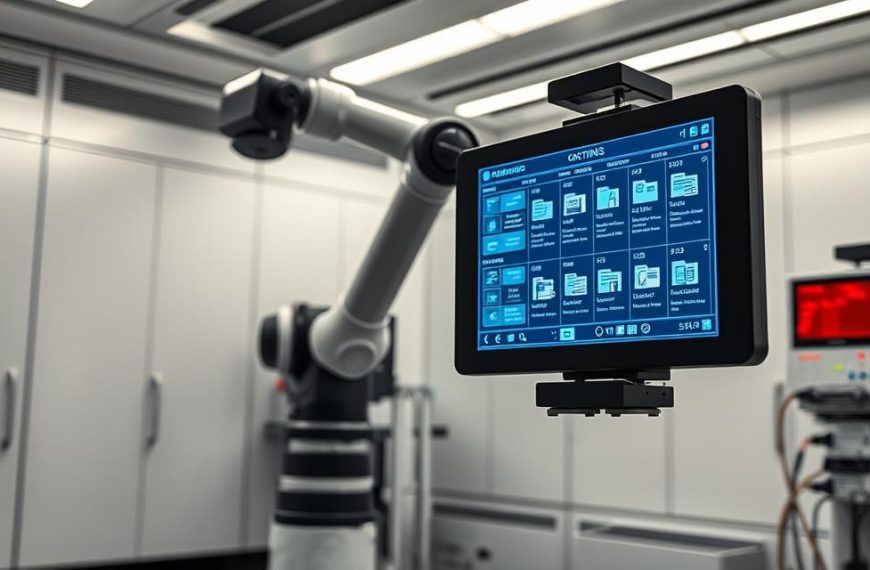The proliferation of artificial intelligence tools in content creation has led to a growing challenge: identifying content generated by machines.
As AI writing becomes more sophisticated, the need for reliable detection methods has become paramount for educators, publishers, and content creators seeking to verify the authenticity of written material.
The detector technology has emerged as an essential tool to distinguish between human and machine-written text, ensuring originality and maintaining content integrity.
By understanding how AI checkers work, individuals can leverage their capabilities to uphold academic honesty and transparency in content creation.
Understanding AI-Generated Content
The increasing sophistication of AI writing tools has made it difficult to detect AI-generated content, threatening the value of human creativity. As a result, it’s essential to understand the implications of AI-generated content on our digital landscape.
The Rise of AI Writing Tools
AI writing tools have become increasingly advanced, enabling the generation of high-quality content that often mimics human writing. This has led to a significant increase in AI-generated content across various platforms.
Why Detecting AI Content Matters
Detecting AI-generated content is crucial for maintaining originality and trust in digital communications. Undetected AI-generated content can undermine the credibility of published materials and have negative impacts on SEO and content quality. Furthermore, it raises ethical concerns about passing off AI-generated content as human-written without proper disclosure.
The importance of detecting AI-generated content cannot be overstated. It helps preserve the value of genuine human creativity, perspective, and expertise in writing. By exploring the significance of maintaining content authenticity, particularly in academic settings, we can better understand the need for effective AI detection methods.
What Is an AI Checker?
AI checkers are specialised tools designed to detect content generated by artificial intelligence. These tools are crucial in maintaining the authenticity and originality of digital text.
Definition and Purpose
An AI checker or AI detector is a software application that uses complex algorithms to analyse writing patterns, predictability, and structure to determine if a piece of content is likely to have been generated by a human or AI.
How AI Checkers Differ from Plagiarism Tools
While both AI detection tools and plagiarism checkers evaluate text originality, they serve different purposes. Plagiarism checkers compare text against vast databases to identify copied content. In contrast, AI checkers analyse linguistic patterns and stylistic elements to detect machine-generated original content.
The key differences lie in their primary function and detection methodology. Plagiarism checkers focus on identifying content copied from existing sources, whereas AI checkers identify machine-generated original content.
How AI Detection Technology Works
AI detection tools employ sophisticated techniques to distinguish between human and AI-generated content. According to Grammarly, their AI detection technology breaks down the text into smaller sections, checking each against a model for language patterns typically indicative of AI-generated text. This process involves a combination of pattern recognition, machine learning, and language analysis techniques.
Pattern Recognition and Machine Learning
Pattern recognition plays a crucial role in AI detection technology. By analyzing vast amounts of data, AI detectors can identify patterns that are characteristic of AI-generated content. As stated by experts, “AI-generated text often lacks the nuances and inconsistencies that are typical of human writing.” Turnitin’s AI detection capabilities are a prime example of how machine learning algorithms can be trained to recognize these patterns. This enables the detection of subtle differences between human and AI-generated content.
Language Analysis Techniques
Language analysis is another vital component of AI detection technology. AI detectors examine various aspects of the text, including sentence structure, vocabulary diversity, and stylistic consistency. As noted, “Human writing often contains inconsistencies and idiosyncrasies, while AI-generated text tends to be more uniform.” By analyzing these features, AI detection tools can determine whether a piece of content is likely to have been generated by a human or a machine. The use of natural language processing allows detection systems to identify subtle patterns in word choice and phrasing that often distinguish AI writing.
Overall, the combination of pattern recognition, machine learning, and language analysis techniques makes AI detection technology a powerful tool for identifying AI-generated content.
Key Features of Effective AI Checkers
To detect AI-generated content effectively, AI checkers must possess certain key features that enable them to perform accurately and efficiently. One of the primary aspects of an effective AI checker is its detection capability.
Detection Accuracy
The accuracy of an AI checker is paramount. It relies on sophisticated algorithms and machine learning models to identify AI-generated content. For more information on how AI checkers work, you can visit ZDNet’s article on AI checkers.
User-Friendly Interface
A user-friendly interface is crucial for making the AI checker accessible to a wide range of users. It should be intuitive, allowing users to easily navigate and utilise its features.
Reporting Capabilities
Effective AI checkers also offer comprehensive reporting capabilities, providing users with detailed analysis and data on the detected content. These reports can be generated in various formats, including PDF and online reports, which can be shared or stored as needed.
By incorporating these key features, AI checkers can provide accurate and reliable detection of AI-generated content, supporting various applications across academic, professional, and publishing contexts.
Popular AI Checker Tools in 2023
As the use of AI in content creation expands, the importance of AI checkers in maintaining content authenticity has become more pronounced. Several tools have emerged to cater to this need, offering a range of features to detect AI-generated content effectively.
Grammarly AI Detector
Grammarly’s AI Detector is a sophisticated tool that analyses writing patterns to identify AI-generated content. It is part of Grammarly’s suite of tools designed to enhance writing quality and authenticity. The detector is known for its accurate detection capabilities, making it a valuable resource for those looking to verify the originality of their content.
Decopy AI Detector
Decopy AI Detector is a smart AI checker that analyses style, structure, and language to identify AI-written text. It focuses on human-like writing traits for accurate AI detection and protects originality. Key features include fast detection capabilities, identifying content from tools like ChatGPT or Claude in seconds, and a free detector model with minimal usage limitations.
Grammarly’s AI Detection Capabilities
Grammarly’s AI detection capabilities are revolutionising the way we verify the authenticity of written content. Grammarly provides a range of AI-powered writing tools, including a Grammar Checker, Plagiarism Checker, Cover Letter Generator, and AI Content Detector.
How Grammarly Identifies AI Content
Grammarly’s AI detector uses advanced algorithms to analyse the syntax, semantics, and style of the text to determine if it is AI-generated. This process involves complex pattern recognition and machine learning techniques to identify subtle differences in language usage.
Percentage Scoring System
The AI detector provides a percentage score indicating the likelihood that the content is AI-generated. This scoring system helps users understand the authenticity of their content and make informed decisions about its use.
Integration with Other Grammarly Features
Grammarly’s AI detection capabilities are seamlessly integrated with its other features, such as grammar checking and plagiarism detection. This integration enables users to create content that is not only authentic but also polished and effective, leveraging the full potential of Grammarly’s tools to improve their grammar and overall writing quality.
Decopy AI Detector: A Comprehensive Solution
With its cutting-edge technology, Decopy AI Detector provides a comprehensive solution for detecting AI-generated content. This tool is designed to be highly effective in identifying the authenticity of digital content.
Fast Detection and Analysis
Decopy AI Detector boasts rapid detection capabilities, enabling users to quickly analyse content. This speed does not compromise the accuracy, ensuring reliable results.
Smart Highlighting and Reporting
The tool features smart highlighting, which identifies AI-generated sections, making it easier to understand the analysis. Comprehensive reporting further enhances the tool’s utility.
Free Usage and Accessibility
One of the standout features of Decopy AI Detector is its free usage model, with no login required and minimal character limits. This approach ensures broad access and protects user privacy by not storing or sharing analysed content.
By offering a free detector with robust capabilities, Decopy democratises AI detection technology, making it accessible to users with varying needs and resources.
Accuracy of AI Checkers
AI checkers have made significant progress in identifying AI-generated content, but accuracy remains a key concern. The effectiveness of these tools hinges on their ability to detect AI-generated content without generating excessive false positives.
Limitations and False Positives
Despite advancements, AI detection tools still face challenges, including false positives where human-generated content is incorrectly identified as AI-generated. This can occur due to the complexity of language and the limitations of current detection models.
Continuous Improvement in Detection Models
To address these challenges, companies like Grammarly are committed to improving their detection models through comprehensive training on diverse datasets and incorporating user feedback. This involves refining algorithms and expanding data to enhance detection capabilities and improve overall accuracy
Use Cases for AI Content Detection
The application of AI content detection spans multiple industries, transforming how we approach content authenticity. As AI-generated content becomes more sophisticated, the need to detect such content has grown across various sectors.
Academic Integrity
In academic settings, AI content detection is crucial for maintaining integrity. Universities are increasingly using AI detectors to check for AI-generated writing, often combining AI content checkers with plagiarism checkers to prevent academic misconduct. This helps ensure that students’ work is original and not produced by AI tools.
Content Marketing and SEO
In the realm of content marketing and SEO, AI detection tools help maintain the authenticity of content. By identifying AI-generated content, businesses can ensure that their marketing strategies are based on genuine human-created material, potentially improving their credibility with their audience.
Publishing and Journalism
Publishers and news organizations are implementing AI detection as part of their editorial workflows to ensure content authenticity. The importance of transparency and human judgment in journalism cannot be overstated, as reader trust depends on it. Publications are developing policies around AI usage and disclosure, balancing the efficiency AI brings with the need for human perspective in quality journalism.
| Industry | Use of AI Detection | Benefits |
|---|---|---|
| Academia | Checking for AI-generated assignments | Maintains academic integrity |
| Content Marketing | Identifying AI-generated marketing content | Ensures authenticity, improves credibility |
| Publishing and Journalism | Detecting AI-generated news articles | Maintains transparency, ensures human judgment |
By leveraging AI detection technology, various industries can ensure the authenticity and quality of their content, supporting their respective standards and trust with their audiences.
How to Use an AI Checker Effectively
Effectively utilising an AI checker requires a comprehensive understanding of its capabilities and limitations. AI detectors can indicate characteristics found in human-written text as well as characteristics commonly found in AI-generated writing, such as language patterns that seem robotic or generic.
Step-by-Step Guide
To use an AI checker effectively, follow these steps: first, input the content you wish to check into the AI detection tool. Next, review the detection results, paying close attention to the confidence levels and percentage scores provided. It’s essential to contextualise these results based on the content type, writing style, and the specific AI checker being used.
Interpreting Results Correctly
Interpreting AI detection results correctly is crucial for making informed decisions about the accuracy of the content. Understand that these results represent probabilities rather than definitive judgments. Different confidence levels and percentage scores can significantly impact the determination of AI generation likelihood. Apply human judgment alongside automated detection, particularly in borderline cases, to ensure the most accurate assessment of the writing style and content authenticity.
Improving Content Flagged as AI-Generated
When content is flagged as AI-generated, it often lacks the personal touch that makes writing engaging and relatable. To improve such content, it’s essential to infuse it with a personal voice and style.
Adding Personal Voice and Style
Incorporating personal anecdotes, emotional expressions, and varied sentence structures can make AI-generated content feel more human. Writers can use it to get a gut check on how their content comes across and identify places where adding a more personal voice might strengthen their message.
- Use first-person narratives to create a sense of ownership and authenticity.
- Incorporate emotional language to evoke feelings in the reader.
- Vary sentence length and structure to create a natural flow.
Restructuring and Editing Techniques
Restructuring AI-generated content involves breaking predictable patterns and creating a more organic flow. This can be achieved by reordering information, using transitional elements, and varying paragraph lengths.
| Technique | Description | Benefit |
|---|---|---|
| Restructuring | Reordering information for a more natural flow | Improves readability and engagement |
| Editing | Refining language and tone | Enhances clarity and authenticity |
| Transitional Elements | Using connecting words and phrases | Creates a smoother flow between ideas |
By implementing these techniques, writers can transform AI-generated drafts into content that feels more authentically human, leveraging the efficiency of AI while maintaining human quality in the writing process.
Ethical Considerations in AI Detection
The growing reliance on AI checkers raises important questions about the ethical considerations involved in their application. As these tools become more prevalent, it’s essential to examine the potential biases and privacy concerns associated with their use.
Bias in AI Detection Systems
One of the significant ethical issues with AI detection systems is the potential for bias. If the training data for these systems is skewed or incomplete, the results can be inaccurate or discriminatory. For instance, an AI checker trained predominantly on content from a specific demographic may struggle to accurately assess content from other groups. To mitigate this, developers must ensure that their training data is diverse and representative.
Privacy Concerns
Privacy is another critical ethical consideration. When users submit their content to AI detection services, they may be exposing sensitive information. It’s crucial for service providers to have transparent privacy policies that clearly outline how user content is handled, stored, and protected. Key considerations include:
- Minimizing data retention to only what’s necessary for detection purposes
- Implementing robust security measures to safeguard user content
- Ensuring that user data is not reused or shared without explicit consent
Users must be aware of how their content is being accessed and analyzed. The balance between effective detection, which requires access to content, and maintaining appropriate privacy protections is delicate. Service providers must prioritize transparency and security to build trust with their users.
By acknowledging and addressing these ethical concerns, we can work towards developing AI detection systems that are not only effective but also fair and respectful of user privacy and content rights.
The Future of AI Content Detection
The ongoing development of AI content detection technology is crucial in maintaining content authenticity. As AI-generated content becomes increasingly sophisticated, the need for advanced detection methods grows.
Evolving AI Models and Detection Methods
The evolution of AI models directly impacts the effectiveness of content detection. New AI models can generate content that is more nuanced and human-like, challenging detection systems. To counter this, detection methods must also evolve, incorporating more sophisticated algorithms and machine learning techniques to identify AI-generated content accurately.
The Arms Race Between Generation and Detection
The relationship between AI content generation and detection is akin to an arms race. Advances in AI generation capabilities spur improvements in detection methodology, which in turn drive further advancements in generation. This dynamic has significant implications for content creators, publishers, and educational institutions, as they must continually adapt to new technologies and methods.
Key aspects of this ongoing competition include:
- The continuous improvement in AI detection models to keep pace with evolving AI generation capabilities.
- The potential for an equilibrium point where detection and generation capabilities stabilize.
- The impact on our understanding of content authenticity and verification in the digital age.
When to Cite AI Usage
With AI playing a larger role in writing, it’s essential to establish clear guidelines for citing AI assistance. As AI-generated content becomes more prevalent, understanding the importance of proper citation is crucial for maintaining academic and professional integrity.
Academic and Professional Standards
In academic and professional settings, citing AI usage is becoming increasingly important to avoid plagiarism and ensure transparency. Different institutions and organisations may have varying standards for citing AI-generated content, but the underlying principle remains the same: to acknowledge the role of AI in the work.
Proper Citation Methods
Tools like Grammarly simplify the citation process by generating citations for AI usage automatically. When using AI tools, it’s recommended to disclose this with a citation. The extent of AI involvement can vary, from minor editing assistance to substantial content generation, and citation practices should reflect this. Emerging citation formats are being developed to acknowledge AI contributions to writing and content creation.
Benefits of Using AI Checkers Responsibly
Responsible AI checker usage is crucial for building trust with audiences and maintaining content integrity. When utilised effectively, AI checkers can significantly enhance the quality and authenticity of content.
Maintaining Content Authenticity
Maintaining human authenticity in content creation fosters deeper connections with audiences. According to the data, 85% of students using Grammarly report that it is an essential tool for them to do well in school, highlighting the importance of authenticity in academic writing.
Transparency about AI usage builds credibility with readers, clients, and other stakeholders. By being open about the use of AI tools, writers can demonstrate their commitment to quality and integrity in communications.
Building Trust with Your Audience
Building trust with your audience is crucial for content creators. When users feel confident in the authenticity of the content, they are more likely to engage and remain loyal. 70% of Grammarly users report that Grammarly gives them the confidence to write in their own voice, underscoring the importance of authenticity in writing.
| Benefits | Description | Impact |
|---|---|---|
| Content Authenticity | Maintaining human touch in content | Deeper audience connection |
| Transparency | Openness about AI usage | Credibility and trust |
| Audience Trust | Confidence in content authenticity | Stronger engagement and loyalty |
By using AI checkers responsibly, content creators can ensure that their work is both original and engaging. This responsible approach translates to tangible benefits, including stronger audience engagement and loyalty.
Conclusion
As we navigate the complexities of AI-generated content, it’s essential to understand the role of AI checkers in maintaining authenticity. AI checkers play a vital part in the writing process, ensuring that the content is original and not plagiarised. The key insights from this article highlight the importance of balancing AI efficiency with human creativity and perspective in content creation.
The evolving nature of both AI generation and detection technologies necessitates ongoing awareness of best practices. Transparency and proper attribution when leveraging AI tools are crucial. AI checker technology is not just a technical verification step, but part of a broader commitment to content quality and integrity.
By adopting responsible AI usage and detection practices, we can preserve the value of human creativity and expertise in writing. The future relationship between human writers and AI tools should be seen as complementary rather than adversarial. By implementing these insights, readers can enhance their content creation and verification processes, ultimately reducing the risk of plagiarism.























